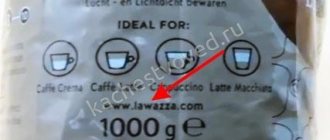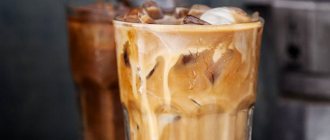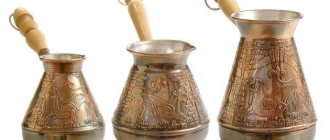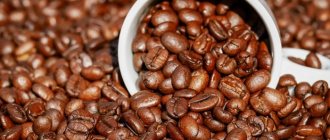“Coffee” – he or it?
Today, coffee is one of the most popular drinks among residents of different countries of the world. Over many years, and in some countries even centuries of love for this drink, people have come up with a large number of its varieties, but...
But it turns out that coffee is not only a drink beloved by many, but also a subject of controversy. The question is, “What kind of word is “coffee”?” is very popular and has already become boring to many of his admirers. Writers and philologists have been fighting for the masculine gender for centuries, self-confident grammarians argue with them and defend the form “it,” and those who don’t know rush between these two opinions in an attempt to understand which option is correct. It is precisely because of misunderstandings with the gender of this word that it has become difficult to choose the appropriate definitions for it - “delicious” or “tasty”, “fragrant” or “fragrant”, “what” or “which”, etc.
So what do you call coffee when ordering it, for example, in a cafe or restaurant?
Which coffee drink is healthier?
Many drinks are made based on coffee, the most popular of which are:
- "Espresso". It is prepared (usually in a coffee maker) exclusively from beans with the maximum degree of roasting. It has a low calorie content (7 calories). Served in 30-35 ml cups, it contains approximately 63 mg of caffeine. There are several classic variations: “lango” - diluted with water up to 55 ml, “Americano” - up to 150-160 ml, and “doppio” - double “expresso” (contains approximately 125 mg of caffeine).
- "Cappuccino". It is also produced on an espresso basis. Whipped milk is added to the drink (70-80% of the drink consists of milk). The caffeine content is similar to espresso. All ingredients are served warm in a cup with a volume of 150-190 ml. Energy value – 105 calories per 150 ml glass.
- Macchiato is a mixture of espresso and milk foam in a 1:1 ratio. Volume – 60-70 ml. Nutritional value: 66 calories.
- "Latte" . It is a milk drink. 75% is represented by milk. Served in transparent vessels with a volume of about 200 ml. Energy value – 112 calories.
- Moccacino is a coffee drink with the addition of chocolate, cocoa powder or chocolate syrup. Served in glasses with a volume of 200-250 ml. Contains about 270-320 calories.
Considering the characteristics of each drink, we can conclude that the most useful are “espresso” in its pure form and cappuccino. They are distinguished by sufficient caffeine content and low calorie content.
A little history...
The word “coffee” itself appeared in everyday life in the 17th century. At that time, its more common forms were “coffee” or “coffee”. The words "coffee" or "cafe" were used very rarely. There is an opinion that the word “coffee” came into Russian from the Dutch language, in which the drink is called “koffie”. Another version suggests his French origin. Be that as it may, in those days this aromatic drink was called “coffee” and, therefore, the masculine gender was quite firmly attached to it. The phrases “strong coffee”, “hot coffee” or “fragrant coffee” were quite common in the Russian language of that time. But the years passed, and the word “coffee” gradually turned into the word “coffee”, which is well known to modern people, but did not lose its masculine gender. “Coffee” first appeared in dictionaries back in 1762. And it was after the word acquired its modern form that the first disagreements began to arise regarding its belonging to the masculine gender.
About a hundred years ago, the famous Russian philologist Vasily Ilyich Chernyshev drew attention to the contradictions associated with this word. It was at that time that the gender of the word “coffee” had already begun to raise questions, despite the fact that the usual form of this word at the beginning of the twentieth century was the words “coffee” or “coffee”. So, Vasily Ilyich, back in the early twentieth century, Fr. However, in many explanatory dictionaries compiled by various authors, the word “coffee” still refers to the masculine gender. The possibility of using this word using the neuter gender was considered by some to be possible only in colloquial speech. And the writers and poets who created their masterpieces in those days used the word “coffee” in the masculine gender in their creations.
Grain or capsules? Arabica or Robusta? Which coffee is best for the office?
It's hard to imagine a modern office without a coffee machine. But how can you make sure that most of your employees (and not just aesthetes and avid coffee drinkers) like the aromatic drink made from it? Much depends on what you “charge” your machine with: beans or ground coffee, Arabica or Robusta, light roast or dark. The origin of the raw materials is also important - it can be grown in America, Africa or Asia (and these are often radically different tastes) - and the coffee machine itself must be chosen wisely. To make sense of it all, Inc. interviewed the founders of Russian coffee companies. The main conclusion: it is better to buy coffee in beans and grind it immediately before preparation (otherwise some of the taste and aroma will be lost), but with other questions everything is not so clear.
Ilya Savinov
founder of the online store Torrefacto
Coffee is a perishable product. When ground, it spoils and quickly acquires an unpleasant, rancid taste. Therefore, it is always better to use grains. And they should be ground immediately before preparation - an automatic coffee machine allows you to do this without unnecessary labor costs.
I am a supporter and promoter of robusta, but in its pure form it can be very bitter. Therefore, the best option is mixtures with a quarter or half of it. The main advantage of Robusta is its high caffeine content: about 3% versus 1.5% in Arabica. It is non-acidic and produces a dark chocolatey bitterness in the cup that suits the taste of many coffee drinkers.
If we talk about Arabica, I would recommend coffee from Brazil or India . It is inexpensive and not very acidic (many people don’t like sourness in coffee). Arabica from the Dominican Republic and Cuba is good, but more expensive. And if you want something softer and slightly sour, you should look towards Costa Rica, Guatemala, Honduras and Colombia. African Arabica for the most part is much more acidic, although there are exceptions everywhere.
It is better to choose a medium and slightly darker degree of roasting. Very dark coffee will be very bitter, and too light coffee will be “underdeveloped”, sour-bitter.
Read also
New and invigorating: how roasters and traders make money from coffee gourmets
A bean coffee machine is the simplest and most convenient option for the office. You can experiment with different beans, roasters, and varieties. Capsules are also good, but you need to choose the manufacturer very carefully and you will have less freedom to experiment.
Filter machines themselves are not bad, but we do not have as developed a filter coffee culture as, say, in the States, where it is a standard drink. We still drink more Americano and drinks with milk (cappuccino, latte and the like). In addition, in this case you will also need a separate coffee grinder. A lot of drink is brewed in a filter machine at once, and it needs to be poured into cups in about half an hour (later it begins to deteriorate: an unpleasant metallic taste appears, the coffee tastes heavy).
Artem Temirov
co-founder of the coffee cooperative "Cherny"
Ground coffee very quickly loses its aromatic properties, and over time, its taste. If you want your employees not just to refuel with coffee like bio-robots, but to enjoy the process, you need to buy beans. But they should also be ground right before cooking (otherwise there will be less taste and aroma).
The only reason to buy Robusta is to save money on coffee. Arabica has a milder taste and has more aroma (and is more complex). And robusta is most often very simple, sharp and bitter. In addition, it contains significantly more caffeine and chlorine oxide, which means there is a higher likelihood that the body of one of the employees will react negatively to such coffee.
Read also
Ideal fundraising, or how to raise more than 4 million rubles to restart a business in a month and a half - the case of the Cherny cooperative
When choosing Arabica beans, the main thing is not to buy over-roasted beans. With light and medium roasts, the taste of coffee is soft and balanced, there is no bitterness and overall more aroma and taste than with dark roasts. And if you want to please the majority of your employees, choose American Arabica beans from Costa Rica, El Salvador, Honduras, and Brazil. But the degree of roasting still plays a key role.
I am not a supporter of capsule coffee machines: they are convenient, but very environmentally unfriendly. If the office can afford to buy good coffee beans, then it needs a suitable machine.
Anton Ovchinnikov
co-founder of the online store “Two Coffee Maniacs”
The coffee bean is like a capsule in which smells and tastes are hidden. After grinding, the essential oils contained in it come out and give that same coffee aroma. But these are volatile substances, and the longer ground coffee interacts with air, the less taste and aroma it retains. Ideally, grind the grains immediately before cooking.
Robusta is excessive caffeine, strength and bitterness. We don't sell it on principle. The taste and aroma are Arabica.
Medium roasting allows you to maximize the taste and aroma of the grain. When dark, part of the taste inherent in each type of Arabica is lost. If you take beans from different countries and roast them too much, the difference in taste will be leveled out - the individual notes inherent in each lot will be lost.
To get the perfect cup of coffee, you need everything as fresh as possible: the bean harvest, roasting, grinding, water. Capsule coffee cannot give such results. At a minimum, it is not freshly roasted or freshly ground. Therefore, coffee from a grain coffee machine, all other things being equal, will be the most delicious and correct.
Mikhail Sharov
founder of the online store Tasty Coffee
It is very important that the coffee is fresh - roasted no more than a month or two ago. Because after roasting, the grain begins to oxidize and lose valuable flavor and aromatic elements. In ground form, coffee becomes much more vulnerable - it comes into stronger contact with the environment and, accordingly, expires much faster. To make coffee, you will have to grind it anyway. But the fresher both the grain itself and the grinding are, the better.
Robusta has its fans, but experience shows that Arabica almost always wins. Because it contains less caffeine and more essential oils (this makes its taste much more complex). Robusta contains almost 2 times more caffeine, which gives the taste of the drink an unpleasant bitterness.
Most people will likely enjoy coffee from Brazil. Almost everyone starts with beans from this country, but gradually moves on to bolder flavors from central America or Africa.
The darker the roast, the more bitterness the coffee has. And the lighter it is, the more acidity. The choice of degree of roasting depends primarily on the cooking method. For Turks, geyser and drip coffee makers, pour over, light and medium are better suited, for espresso - medium and dark.
Good coffee capsules are a great option for the office. Professional espresso machines are unlikely to be suitable - they are difficult to use. But there are automatic espresso machines that make pretty good coffee (provided the beans are good quality). The main argument in their favor is the ability to prepare cappuccino, latte and other popular coffee drinks.
Philip Leites
founder of the Pravda Coffee chain
It is believed that coffee retains its taste for 15 minutes after grinding. Therefore, a coffee machine with beans is the best option. Superautomatic machines, capsule and pod machines (brewed from ground grain) are suitable for the office. Superautomatic machines work with both ground coffee and beans. In the latter case, the coffee will be freshly ground.
Of course, Arabica is better than Robusta (it is used mainly for blends and the production of instant coffee). From my own experience, I can say that the optimal grain for wide consumption is Brasilia Mogiana.
Read also
Own coffee shop vs franchise: what should a coffee lover invest in?
Igor Kondaurov
founder of the online store Coffee Owl Roasters
Ground coffee is only suitable for quick use . After grinding in roasted coffee, all taste and aroma qualities are lost faster, and rancidity appears in the taste.
African beans are always more acidic, bright and citrusy. Coffee from Asia will develop bitterness, alcoholic and tobacco overtones. But America is a story more about balanced taste.
The darker the coffee is roasted, the more bitterness it exhibits. If you like a more acidic taste and brew the drink using a filter method, then you need a light and medium roast. Espresso and espresso-based drinks require medium, while Italian espresso requires dark and deep.
Yuri Filimonov
founder of the online store JustCoffee Factory
Coffee strives to release its flavor and aroma components as quickly as possible, and to absorb all foreign odors. And the smaller its particle, the faster this process occurs. Therefore, it is better to buy coffee in bean form.
First of all, you should pay attention to the freshness of the grain. The manufacturing or roasting date on the package is no earlier than four weeks ago.
There is such a category of coffee: Specialty Coffee (a kind of highest grade), and it is awarded only to Arabica beans. Each lot from a specific region has its own unique taste: in some places there is citrus sourness, and in others there is the sweetness of berries or the aroma of nuts. In robusta, caffeine imparts bitterness and a heavy aroma; it is impossible to feel the nuances of taste.
The green coffee bean is the seed of the berry and tastes like a pea. During the roasting process, the taste changes. When light, herbal, “green” tones predominate, then they are replaced by fruit and floral ones. After the caramelization stage, with medium roasting, sweet caramel and chocolate shades appear. Finally, when a certain temperature is reached, the charcoal flavor becomes dominant.
Each coffee-producing country has its own microclimate and methods of collecting and processing grain, which affects its taste. African varieties have intense acidity and fruity-floral notes. Brazilian ones are less acidic, they have more nutty and chocolate notes. Try and experiment.
How did “coffee” become neuter?
However, everything is changing. Including the rules of the great and mighty Russian language. And today, after the Russian Ministry of Education updated the list of dictionaries and in accordance with the Order of the Ministry of September 1, 2009, the word “coffee” began to refer to the neuter gender . At the same time, many authoritative dictionaries that have not updated their database still classify “coffee” as masculine. In general, it is most likely that both options can be called correct today, but it is, of course, up to you to decide which one to use.
Selecting the degree of roasting
Coffee beans are roasted to give them a unique taste, which depends on the amount of essential oils found inside the bean (there are about 600 types) and the degree to which they are expressed during the roasting process. In other words, the taste and aroma of the drink depends not only on the type of coffee, but also on the degree of roasting of the beans - this information is reflected on the packaging in the form of numbers - from 1 (light roast) to 5 (strong roast). The choice in this case depends solely on taste preferences, but pay attention to the roasting date, remembering that roasted beans retain their aroma for a month, and the more time that passes from this moment, the more the coffee loses in its taste.
Roasting levels:
- Scandinavian (super light) roasting gives the coffee tenderness and softness, the color of the beans is light brown, almost beige.
- American (medium) roasting contributes to the appearance of a slight bitterness in the taste, the color of the beans is rich brown, but this type of roasting does not allow the appearance of essential oils on the surface of the beans, so the taste and aroma are revealed only by a slight hint.
- Vienna roasting - the beans darken and become shiny due to the manifestation of essential oils, and sweetish notes appear in the taste of coffee.
- French (strong) roasting gives the beans an intense chocolate color, and the taste acquires a pleasant bitterness and astringency.
- Italian (very strong) roasting is recognizable by its black, oily beans, and the drink acquires a special expressiveness, velvety and richness - this is a real bitter coffee in the classic version.
But what about other types of coffee?
“Americano” - it or he? This word cannot be found in dictionaries and most often, by analogy with coffee, it is used in the masculine gender. However, according to the new general rule, the gender should become neuter. It can be noted that no one has such a reverent attitude towards “Americano” as to “coffee”. This drink is not a historical monument or a criterion of linguistic illiteracy, and therefore it is up to you to decide how it should be treated. It can only be noted that in the corresponding Wikipedia article, which is dedicated to Americano, this type of coffee appears as a masculine word.
Cappuccino . To begin with, you should pay attention to the spelling of this word. Not cappuccino or cappuccino, but in short - cappuccino. If we talk about gender, then spelling dictionaries allow the use of the word “cappuccino” in both the neuter and masculine gender.
Latte . Many people make a mistake in stress in this word, saying “latTE” instead of “latte”. In Italian, the accent is exactly that – “latte”, so it can be noted that in relation to this word the so-called rule of the source language applies. And the gender of this word, like “cappuccino,” is both masculine and neuter.
Start
The first mention of coffee in Rus' dates back to 1655, when Samuel Collins, the court physician of Tsar Alexei Mikhailovich, prescribed to a crowned patient “boiled coffee, known to the Persians and Turks, and usually after dinner, it is a pretty good remedy for arrogance, runny noses and headaches.”
No one questioned either the doctor’s scholarship or the legitimacy of using the word “coffee” in the neuter gender. Apparently, the king treated the drink precisely as a medicine, and therefore did not understand how he could enjoy it.
Who is this "sap"?
Errors that occur in phraseological units are also not uncommon. In some cases, stable phrases are broken intentionally, in others - out of ignorance of where the phraseological unit came from and what it means.
For example, you can often hear: “He did something on the sly.” But then what is “sap”? And why is he quiet?
In fact, there is no “sap”, but there is a phraseological unit “slyly”, and it came into our language from military usage. “Sapa” (the word is borrowed from the French language) is a hidden tunnel that allows you to unnoticedly approach the enemy or even undermine his fortifications. From this it becomes clear that doing something “on the sly” means unnoticed by others, secretly.
There are still a lot of inexplicable, at first glance, phenomena in the Russian language, amazing secrets and entertaining riddles that are worth the attention of not only philologists and linguists, but also native speakers themselves. Such knowledge will broaden your horizons and help you avoid mistakes in speech. Love your language!











